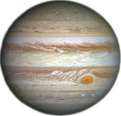When the Doppler effect is mentioned in the context of light, we usually think about color shifting. However, if the light itself is pulsing on and off, then the observed on/off interval is also affected.
Ole Römer used this idea in the 17th century to show that light has a finite speed, well before the Doppler effect was coined. He even came up with a reasonable estimate for its speed! He did this by noting each time that Io enters an eclipse, which happens every other Earth day or so. He then analyzed how its perceived orbital period changes throughout the year.
Light Delay
Römer's original paper didn't have much detail, but we can attempt to recreate what he did in a very approximate way. The following canvas illustrates a fake universe where Earth and Jupiter are stationary, light moves slowly, and the solar system is more compact.
For visualization purposes, we show Jupiter emitting a gray wave while Io is in a total eclipse. In real life, we would observe light reflected from Io, not Jupiter, but the difference is negligible and simplifies our upcoming calculations.
An observer is depicted with a point on the surface of the Earth. This point is white when Io is apparently not in shadow, and black when it is apparently eclipsed.
Linear Movement
If both planets were stationary, Römer would not have been able to determine the speed of light. So let's see what happens when the observer moves around a bit. The movement shown below is totally absurd for the Earth, but bear with me.
| Estimated | Actual | |
|---|---|---|
| Io Period | 3 | |
| Wave Speed | 4 |
Orbital Movement
In the previous vignette, it was hopefully apparent that the observed frequency changed according to Earth's movement direction. Next let's make Earth's movement less absurd, but stay in a crazy universe that has a tightly cramped solar system.
If we record the Earth-Jupiter distance and time at each eclipse, we can do some linear regression and estimate the speed of light in this fake universe. The speed of light is simply the inverted slope in the following graph. I'll explain the Time Offset axis shortly.
| Estimated | Actual | |
|---|---|---|
| Io Period | 3 | |
| Wave Speed | 4 |
In the above chart, Io's actual orbital period was estimated by simply averaging all the apparent periods. Even though the apparent periods were affected by Doppler, this works out because the number of contracted intervals is fairly similar to the number of expanded intervals.
After an estimate is obtained for Io's orbital period, we can obtain an expected actual time for each eclipse, by taking the first eclipse time and adding an integer multiple of our estimate for the Io's orbital period. The Time Offset value in the above chart is the difference between the expected time and the observed time.



